The Veterans’ Administration has announced the VA payment schedule for Aid and Attendance for 2019 (actually effective starting December 1, 2018.)
The VA payment schedule increases each year there is a cost-of-living increase in Social Security benefits. The new maximum monthly payments are as follows:
Thank you for reading this post, don't forget to subscribe!- Single Veteran $1880
- Married Veteran $2230
- Widow of Veteran $1209
As we reported in an earlier edition of this blog, there is now a 3 year or 36 month look-back for the Aid and Attendance application process. Before determining the VA payment schedule, the VA will apply the look-back period.
That means for an application submitted after the effective date of the rule change, the VA will ask if the applicant or the spouse has made a transfer for less than value which ended up decreasing the household net worth. If the answer is “yes” then the VA will implement an ineligibility period, not to exceed 5 years. The period could be shorter if the penalized transfer is small.
Another new provision is a clear standard for the asset cap. This clear standard determines when the VA payment schedule can be applied.
The VA chose to adopt the Medicaid standard for community spouse resource allowance which for 2018 is $123,600 (changing to $126,420 for 2019). Strangely the VA is choosing to count household income along with non-exempt assets as part of the net worth calculation. Therefore the higher the income, the fewer assets one may keep and still qualify. However, there is still the possibility of off-setting income via unreimbursed medical expenses to reduce the income back to nothing.
The home is still exempt from counting against the applicant unless it is sold. Even then, if the proceeds are used to purchase another home of equal or greater value or to buy other items or services which benefit the Veteran or spouse, there will be no ineligibility based on the home sale. There is no limit to the value of the home. However, the VA arbitrarily limits the size of the exempt property to 2 acres. Anything over 2 acres would be countable in the applicant’s net worth unless the additional acreage is not marketable (e.g., if there are zoning restrictions against dividing the land.)
It is important to note that only transfers which result in making the applicant eligible will result in an ineligibility period.
For example, a single veteran who gave his church $90,000 last year, and now has only $10,000 besides his home would not be penalized because the total of $100,000 would still be eligible under the new rules.
